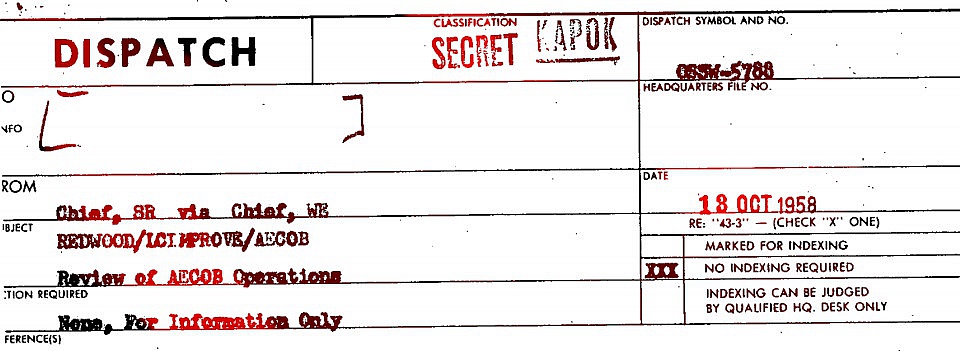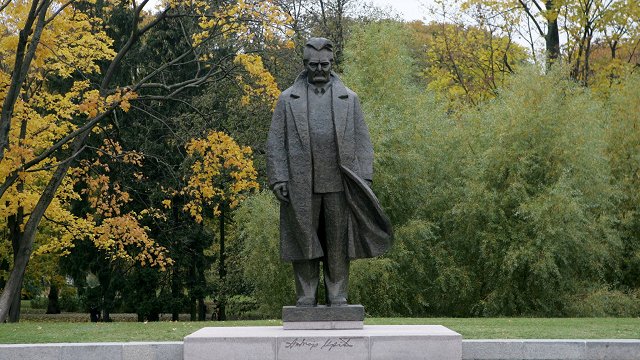The latest and final report by Rus.lsm.lv in the 'Forest brothers' series uses information made available only early this year to show that by the late 1950s the CIA came to suspect that the resistance movements in the Baltic states might actually be controlled by the KGB, maybe since their very inception.
The CIA's AECOB project in which agents recruited in the West were infiltrated into Latvia, was officially scrapped on January 1, 1958. Earlier LSM reported that the operation received the first serious blow in summer 1957 when Soviet national newspapers reported the capture of several agents who were dropped into the Latvian SSR.
However the CIA still considered part of its agent network to be 'in healthy condition' in 1958, according to a document written in the spring of that year testifying to 'freedom from control' of one of its agents in Latvia.
The agency's position must have been reassessed after publications over Western agent networks in the USSR appeared in central Soviet media. The CIA apparently received the last of the series of spy stories in March 1958 and eventually reassessed its position as agents ceased contact one after another and in some cases saw members of the Baltic diaspora living in the West disappear and magically 'pop up' on the Soviet of the Iron curtain.
It all adds up to a confusing game of cross and double-cross in which all motivations and actions become suspect, so typical of the Cold War era.
1. Dispatch. Review of AECOB operations.
Secret. October 18, 1958.
"[...]
5. Conclusion
A. It must be assumed that the Soviets have known the American secret service involvement in TIEBAR [Swedish intelligence] Baltic operations since at least 1952. Aldonis' [the daughter of an agent; defected to the USSR with her husband] defection is only the most recent source the RIB has had on this activity. Therefore, the knowledge of [American-Swedish] Baltic operations that Aldonis possesses should be considered primarily as "confirmation" to what the RIB already knows.
B. The interrelation between the TIEBAR Estonian, Latvian end Lithuanian REDSOX [recruiting] operations, and the dispatch of TILESTONE/BAKER after the successful escape to the USSR of an agent for this operation, gave the RIS sufficient leads back in 1949 to have controlled all TIEBAR assets within the Baltic areas since that tine.
C. The Ogonek [Soviet newspaper] expose in 1957 centered around [Swedish-American] REDSOX assets. in Estonia. It is speculative whether the RIB made misstatements in the articles, or whether it did not actually have all facts on hand.
D. The cross fertilisation of Baltic operations both in Sweden, and in the Baltic areas, plus the overlapping interests and relations among several [CIA] stations as well as [British secret services] makes it impossibleto reach any valid conclusion... of what, if any, inside asset remain clean. Thereon, future direction of TILBURY/1 and AECOB-7 must be based on the assumption that they are RIB controlled. Since the Ogonek articles... [Swedish agent cooperating with the CIA] TIEBAR-8 has considered all his former inside agents as compromised..."
Here the CIA essentially admits that their Baltic assets may have been on some degree actually controlled by the KGB.
A few years later the CIA reached the more far-reaching conclusion that the Baltic 'Forest brothers' were also infiltrated by the KGB.
Rus.lsm.lv was not able to locate documents showing why the CIA took such a stance, however an excerpt from a document dating to the mid-60s testifies that this point of view was neither new, nor extraordinary. It is mentioned as a truth that was generally known for years.
These documents relate to the case of Eric Haine, an Estonian man who had fled to the West and eventually moved to Canada. He was however plagued by accusations that he's working for the KGB - the CIA tipped off the Estonian diaspora, the members of which made the said accusations. Haine eventually went to court to try to clear his name and, as proof of being clear of Russian control, he told he had served at the Estonian Waffen SS legion and had been a member of the Estonian 'Forest brothers' movement.
Canadian secret services became interested in his case and eventually turned to the CIA, the more experienced agency, for help.
2. Dispatch. Response to SMABOVE [Canadian secret service] comments.
June 16, 1966.
[...]
In previous communications to you we have noted the many suspicious and highly questionable elements of HEINE's biography, but we have perhaps not sufficiently highlighted that period relating to his alleged partisan activities, starting with July 1946 when he claims to have escaped from a Soviet labor camp in the Tallinn harbor area, joined a partisan group (of the Forest Brothers) and engaged in numerous anti-Soviet activities until his arrest in Tallinn by the NKVD in June 1950.
Information available in our files indicates that Soviet State Security organs had penetrated the partisan movement in the early stages of its formation during the first Soviet occupation, used these penetrations for the collection of information on German troop movements during the German occupation and, shortly after the Soviet re-occupation, assumed control of the partisan organization and dispatched agents to the West--using the partisan organization as cover.
During the period when HEINE claims he was with the partisans (1946-1950) and through the middle 1950s, Western Intelligence Services, including [erased], dispatched agents into the area, with their arrivals coordinated with and supported by the partisans. By October 1955 it was established that the entire partisan complex in Estonia was controlled by the KGB.
By 1956, it was established that parallel partisan-movements in Latvia and Lithuania were also controlled by the KGB and that all operations into the Baltic republics were under hostile control, probably froth the outset.
(Information provided later by a defector confirmed our earlier conclusions as did an analysis of the information obtained through our interviews with Arthur HAMAN [a purported defector to the West who however was greeted with disbelief and eventually returned to the USSR where he tried, according to CIA files, to recruit an American professor] in 1962.)
In March 1957 Moscow Radio announced the capture of numerous Swedish and American agents who had been sent into Estonia and'who utilized the "Forest Brothers" as a support base. A short time later the Soviets surfaced in detail their Control of the "Forest Brothers" (so named) through'a serialized spy story published in the magazine OGONYOK...
We still feel that it is most likely that HEINE was recruited by the RIS after his first arrest in 1940 and was subsequently dispatched to Germany as a recruited agent. The fact that the Germans apparently accepted him without suspicion during his service in the German Army is not too difficult to understand, given the large number of Balts the Germans had to deal with.
With respect to his request to be released from political police service in Estonia and to be returned to front line duty, we have only his word that such a transfer was at his own request and we have no independent source to corroborate this period of HEINE's background...
HEINE's determination to pursue... accusations to an ultimate conclusion through American courts may have been based on an ad hoc decision of the KGB. However, we feel rather strongly that HEINE may have been, prepared for such an eventuality during his training period.
We are aware of one specific operation, for which the Estonian partisans were used as cover, in which the KGB specifically instructed the agent during his training as to what he should do if confronted by the Americans with charges which might result in the agent being imprisoned.
The agent was advised by a "high level KGB official in Moscow" that if he should find himself the victim of such an attempt by the Americans, the agent was to proclaim loudly in court that the charge was false, and he could be assured that the 'American defense counsel would give him every assistance in their power. The KGB official further told the agent that American defense counsel like to make names for themselves in such cities and would do everything they could to help him.



























